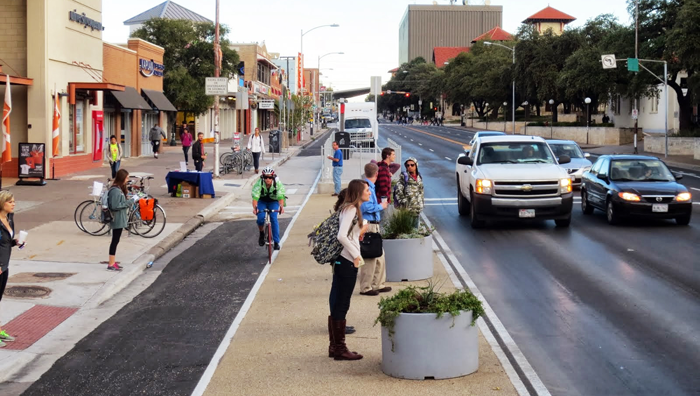How Bike Lanes & Shared Streets Pay for Themselves, and Then Some

Shared streets, like this proposed project in Seattle, make room on the roadway not just for cars, but for bicyclists, pedestrians and transit riders as well. | Rendering by Mithun.
New research suggests that “Complete Streets” — those carefully designed, multi-modal travel corridors that often include, yes, bike lanes — can yield handsome returns on investment for cities. Like millions, sometimes realized in no more than a year, because shared streets reduce collisions, which in turn saves money on medical costs and property damage. And there’s more. These street alterations are also correlated with increased property values and even higher employment numbers.
That’s according to the first major before/after study on the Complete Streets movement, which has touched down in more than 700 cities, counties and states nationwide. The report by Smart Growth America, titled “Safer Streets, Stronger Economies,” studied 37 of these projects —including the installation of the Pine and Spruce Street bike lanes — and found many reasons for optimism:
Compared to conventional transportation projects, these projects were remarkably affordable, and were an inexpensive way to achieve transportation goals. In terms of economic returns, the limited data available suggests Complete Streets projects were related to broader economic gains like increased employment and higher property values.
Although the projects in the study collectively stretched only 44 miles, 80 percent yielded an increase in the surrounding property values and 70 percent saw fewer collisions (out of the projects that were able to supply data for each category). The latter group included Spruce and Pine. There were roughly 15 percent fewer accidents — even without a median divider — after installing the buffered bike lanes on both those streets and eliminating a traffic lane. Meanwhile, the hourly bicycling volume increased by 131 percent and automobile traffic was virtually stagnant. That means that the streets were far safer despite many more cyclists and no fewer cars — a credit to the retrofitted design.
In the fall of 2009, the Spruce and Pine bike lanes were installed as a pilot program — the first project after Mayor Nutter signed his executive order on Complete Streets, which aimed to make all streets accommodating to diverse traveling needs. The executive order offered three prescriptions for city planners to follow:
A. Give full consideration to accommodation of the safety and convenience of all users of the transportation system, be they pedestrians, bicyclists, public transit users or motor vehicle drivers
B. Balance the needs of all users in planning, design, construction, maintenance, and operation; and
C. Prioritize the safety of those traveling in the public right of way, and in particular the safety of children, the elderly, and persons with disabilities. Such efforts shall be known as the City’s “Complete Streets Policy.”
The development of Spruce and Pine proved to be a glowing success. A study of the pilot phase revealed some of the same benefits that were outlined in the Smart Growth America report. The Mayor’s Office of Transportation and Utilities (MOTU) found there was a reduction in cars speeding and more bicycles along Spruce and Pine, and the projects became permanent. And yet, there are still many detractors of bike lanes, including Councilman William K. Greenlee, who last year rejected the reinstallation of bike lanes along 22nd Street between Fairmount and Spring Garden. “I just think it is not safe to back traffic up,” he told PlanPhilly.
But this report shows why well-designed shared spaces which include bike lanes can create a safer environment for drivers and bikers alike. There’s a reason why MOTU created a fat, 160-page handbook on “Complete Streets” which is so detailed that it delves into the finer points of thermoplastic tape on decorative crosswalks. Complete Streets are worth the city’s time and resources. The study showed that they practically pay for themselves.
One project in West Jefferson, North Carolina, spent $300,000 to replace two traffic lights with four-way stops in a downtown streetscape, an investment that saved the city $2.7 million in one year, according to the study. Although that’s an extreme example, the study estimates that the 37 projects it studied were responsible for $18.1 million in collective savings during just one year. Using that sum as a baseline average, it would take less than 8 years for those streets to recoup their cost. And Complete Streets projects are cheap, costing on average $2.1 million, compared to $9 million on average for initiatives in state transportation improvement plans.

